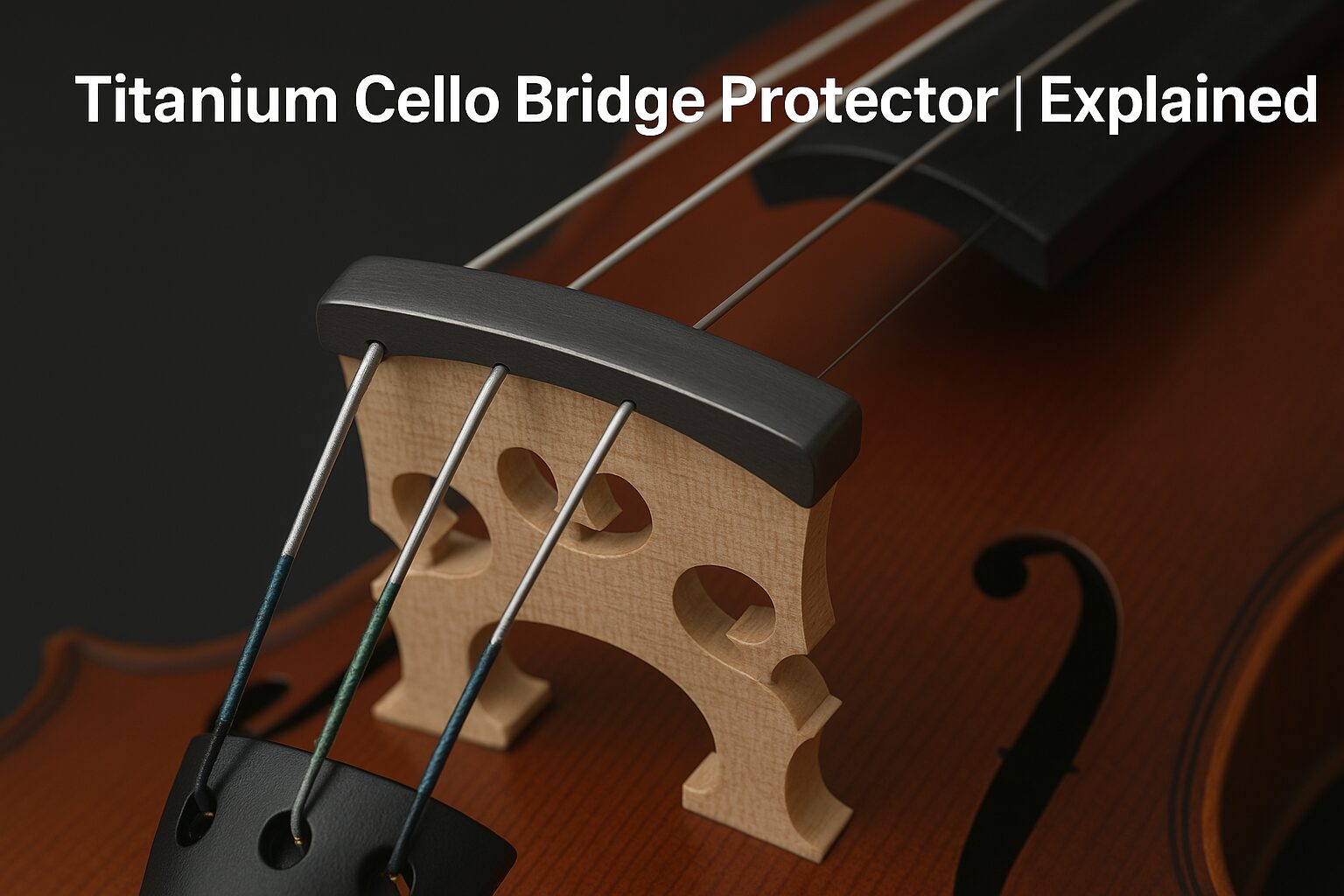uality. One critical aspect that often goes unnoticed is the cello bridge—the part responsible for transferring string vibrations to the body of the cello. As cellists strive to preserve their instruments and optimize sound, a relatively new accessory has gained attention: the Titanium Cello Bridge Protector. But what is it, and why are professionals turning to this innovative solution?
Let’s break it down in this comprehensive guide.
What Is a Titanium Cello Bridge Protector?
A Titanium Cello Bridge Protector is a small but crucial accessory designed to sit under the cello bridge’s feet, providing a protective barrier between the bridge and the cello’s body. Made from high-grade titanium, this protector is engineered to distribute pressure evenly, prevent damage to the instrument, and sometimes even enhance sound quality.
Traditionally, cellists used parchment, leather, or nothing at all to protect the cello top from wear and pressure. Titanium introduces a new level of durability and precision.
Why Titanium and Not Other Materials?
Titanium is known for being lightweight yet incredibly strong. In the context of cello accessories, this means it can protect the delicate wood of the instrument without adding noticeable weight or interfering with sound transmission.
Key advantages of titanium:
-
Non-reactive: Titanium won’t corrode or degrade over time.
-
Hard but gentle: It resists wear while being kind to the cello’s surface.
-
High acoustic conductivity: It transfers vibrations efficiently, which is essential for maintaining tonal clarity.
Compared to plastic, rubber, or even ebony protectors, titanium offers superior longevity and acoustic performance. This makes a Titanium Cello Bridge Protector a favorite among professional cellists who demand the best from their instruments.
How Does a Titanium Cello Bridge Protector Work?
Placed directly under the feet of the bridge, the Titanium Cello Bridge Protector serves two purposes:
-
Protection: It safeguards the top plate of the cello from indentation or cracking caused by the concentrated pressure of the bridge feet.
-
Sound Transmission: Rather than absorbing or dulling vibrations (as rubber might), titanium allows sound waves to pass through with minimal resistance, preserving the richness and resonance of the cello’s tone.
This balance between protection and sound fidelity is what sets titanium apart from traditional materials.
Who Should Use a Titanium Cello Bridge Protector?
While beginners might not prioritize this accessory, intermediate and professional cellists can benefit significantly from using a Titanium Cello Bridge Protector. It’s particularly useful for:
-
Professional performers who play regularly and need consistent tonal output.
-
Studio musicians looking for maximum acoustic clarity during recording sessions.
-
Owners of antique or high-value cellos who want to minimize wear and protect the instrument’s resale or historical value.
-
Cellists in humid or changing climates, where wood expansion and contraction can affect bridge placement and pressure points.
Even students with long-term plans of playing seriously may consider investing in this small but powerful addition.
Installation: How to Fit a Titanium Cello Bridge Protector
Installing a Titanium Cello Bridge Protector is not something you should rush. The protector must be placed accurately to ensure even weight distribution and proper sound transmission. Here’s how it works:
Step-by-Step Guide:
-
Loosen the strings slightly to reduce bridge pressure.
-
Mark the bridge foot location using a pencil or soft marker.
-
Clean the cello surface to ensure no dust or rosin residue remains.
-
Apply the titanium protector under the bridge feet. Some protectors come with adhesive backs; others require professional fitting.
-
Retighten the strings, ensuring the bridge aligns correctly over the protector.
If you’re unsure about the installation process, it’s best to have a luthier handle it. Misaligned protectors can affect tone or even damage the cello top.
Does It Affect the Sound Quality?
One of the main concerns for musicians is whether accessories will compromise tone. Surprisingly, many users report that the Titanium Cello Bridge Protector does not negatively impact sound. In fact, in some cases, it may enhance projection and clarity.
Because titanium is acoustically efficient, it transmits vibrations effectively from the bridge to the soundboard, preserving the cello’s natural voice. The result? You get both protection and performance.
Durability and Maintenance
Titanium is known for its durability. Once installed, a Titanium Cello Bridge Protector requires virtually no maintenance.
Key maintenance tips:
-
Keep the surface clean: Wipe it occasionally with a dry cloth to remove rosin dust.
-
Avoid moisture: While titanium itself is corrosion-resistant, it’s best to avoid excess humidity to preserve the cello’s wood.
-
Check alignment: Every few months, ensure the bridge feet are still properly aligned over the protector.
Properly maintained, a titanium bridge protector can last for decades—a worthwhile investment for long-term instrument care.
Comparing With Other Bridge Protectors
To understand why titanium stands out, let’s compare it with other common protector materials.
| Material | Durability | Acoustic Impact | Cost | Aesthetic |
|---|---|---|---|---|
| Rubber | Medium | Dulls vibrations | Low | Visible |
| Plastic | Low | May hinder resonance | Low | Basic |
| Ebony/Wood | Medium | Neutral | Moderate | Traditional |
| Leather | Low | Muffles tone slightly | Low | Vintage |
| Titanium | High | Enhances/Preserves | High | Sleek |
It’s clear that for players seeking a balance between acoustic performance and durability, the Titanium Cello Bridge Protector wins in most categories.
Cost vs. Value
Titanium accessories aren’t cheap—but they’re also not astronomical. A high-quality Titanium Cello Bridge Protector typically costs between $50 to $150, depending on the brand and customization.
Considering the cost of cello repairs or diminished tone due to bridge damage, this small investment can save you hundreds (or thousands) in the long run. Think of it as an insurance policy for your cello’s top plate and sound quality.
Popular Brands and Where to Buy
Some reputable brands offering Titanium Cello Bridge Protectors include:
-
GEWA
-
Wittner
-
Larsen Accessories
-
TitanPro Music
-
Custom luthier shops
You can find them online on platforms like:
-
Shar Music
-
Amazon
-
Strings by Mail
-
Thomann
-
Your local music store or luthier
When purchasing, ensure you check product specifications and compatibility with your cello’s size (4/4, 3/4, etc.).
Myths and Misconceptions
Despite its growing popularity, some myths still surround the Titanium Cello Bridge Protector. Let’s debunk a few:
-
Myth: Titanium makes your cello sound metallic.
Truth: Titanium is acoustically neutral and won’t alter the tone negatively. -
Myth: It’s only for professionals.
Truth: Anyone serious about preserving their instrument can benefit. -
Myth: Installation is too complex.
Truth: It can be installed easily with professional guidance.
Final Thoughts on the Titanium Cello Bridge Protector
Whether you’re a seasoned professional or an aspiring student, the Titanium Cello Bridge Protector offers a fusion of modern engineering and traditional music craftsmanship. Its role may be small in size, but its impact on protection, performance, and peace of mind is huge.
With its durability, sound-enhancing properties, and sleek design, this protector isn’t just a luxury—it’s becoming a standard for those who want to safeguard their instruments while achieving the best possible sound.
Frequently Asked Questions (FAQs)
Q1: Will it fit all cello types?
Most protectors are designed for 4/4 cellos, but smaller sizes are available. Always check compatibility before buying.
Q2: Does it require any special maintenance?
No. Just occasional cleaning with a dry cloth and checking for alignment.
Q3: Can I use it with carbon-fiber cellos?
Yes. The Titanium Cello Bridge Protector works with both wooden and carbon-fiber instruments.
Q4: Does it interfere with my cello’s natural resonance?
Not at all. In many cases, it actually enhances tonal clarity by preserving consistent bridge pressure.
Q5: Is it worth the price?
If you care about long-term preservation and optimal tone, absolutely. It’s a one-time investment with lasting benefits.















